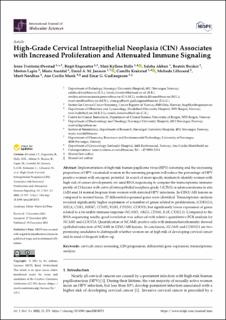| dc.contributor.author | Øvestad, Irene Tveiterås | |
| dc.contributor.author | Engesæter, Birgit Øvstebø | |
| dc.contributor.author | Halle, Mari Kyllesø | |
| dc.contributor.author | Akbari, Saleha | |
| dc.contributor.author | Bicskei, Beatrix | |
| dc.contributor.author | Lapin, Morten | |
| dc.contributor.author | Austdal, Marie | |
| dc.contributor.author | Janssen, Emiel | |
| dc.contributor.author | Krakstad, Camilla | |
| dc.contributor.author | Lillesand, Melinda | |
| dc.contributor.author | Nordhus, Marit | |
| dc.contributor.author | Munk, Ane Cecilie Dæhli | |
| dc.contributor.author | Gudlaugsson, Einar | |
| dc.date.accessioned | 2022-02-17T09:03:05Z | |
| dc.date.available | 2022-02-17T09:03:05Z | |
| dc.date.created | 2022-02-10T14:09:47Z | |
| dc.date.issued | 2021 | |
| dc.identifier.issn | 1422-0067 | |
| dc.identifier.uri | https://hdl.handle.net/11250/2979565 | |
| dc.description.abstract | Implementation of high-risk human papilloma virus (HPV) screening and the increasing proportion of HPV vaccinated women in the screening program will reduce the percentage of HPV positive women with oncogenic potential. In search of more specific markers to identify women with high risk of cancer development, we used RNA sequencing to compare the transcriptomic immune-profile of 13 lesions with cervical intraepithelial neoplasia grade 3 (CIN3) or adenocarcinoma in situ (AIS) and 14 normal biopsies from women with detected HPV infections. In CIN3/AIS lesions as compared to normal tissue, 27 differential expressed genes were identified. Transcriptomic analysis revealed significantly higher expression of a number of genes related to proliferation, (CDKN2A, MELK, CDK1, MKI67, CCNB2, BUB1, FOXM1, CDKN3), but significantly lower expression of genes related to a favorable immune response (NCAM1, ARG1, CD160, IL18, CX3CL1). Compared to the RNA sequencing results, good correlation was achieved with relative quantitative PCR analysis for NCAM1 and CDKN2A. Quantification of NCAM1 positive cells with immunohistochemistry showed epithelial reduction of NCAM1 in CIN3/AIS lesions. In conclusion, NCAM1 and CDKN2A are two promising candidates to distinguish whether women are at high risk of developing cervical cancer and in need of frequent follow-up. | en_US |
| dc.language.iso | eng | en_US |
| dc.publisher | MDPI | en_US |
| dc.rights | Navngivelse 4.0 Internasjonal | * |
| dc.rights.uri | http://creativecommons.org/licenses/by/4.0/deed.no | * |
| dc.title | High-Grade Cervical Intraepithelial Neoplasia (CIN) Associates with Increased Proliferation and Attenuated Immune Signaling | en_US |
| dc.type | Journal article | en_US |
| dc.type | Peer reviewed | en_US |
| dc.description.version | publishedVersion | en_US |
| dc.rights.holder | Copyright 2021 by the authors | en_US |
| dc.source.articlenumber | 373 | en_US |
| cristin.ispublished | true | |
| cristin.fulltext | original | |
| cristin.qualitycode | 1 | |
| dc.identifier.doi | 10.3390/ijms23010373 | |
| dc.identifier.cristin | 2000029 | |
| dc.source.journal | International Journal of Molecular Sciences | en_US |
| dc.identifier.citation | International Journal of Molecular Sciences. 2021, 23 (1), 373. | en_US |
| dc.source.volume | 23 | en_US |
| dc.source.issue | 1 | en_US |

